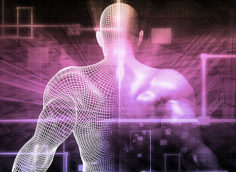Beyond the Warm Up
While a good warm up plays a pivotal roll in physical preparation and injury prevention, it's not the most important training factor. What you do directly after the warm up and before you hit the big lifts is what matters most. Chances are, you're not doing it!
It's not set in stone that you need to do your big compound movement like squats, deadlifts, and bench press first in your training day. Sure, in some cases, doing the multi-joint exercise that also requires a high level of central nervous system response first is appropriate.
But for most lifters who have goals of building muscle and getting progressively stronger over time, pushing the big lifts back in your workout can drastically enhance the feel and function of those big movements.
The most effective way to order your exercises is to include a "primer movement" between your warm up and your first big compound movement of the day. This primer movement serves as an extended "warm up" and lubricates joints, activates specific musculature, and hones movement patterns before challenging your body with near maximal effort sets.
Here are the best primer movements for each type of training day. If you're training full body, pick one. Or hell, incorporate all of them into your primer routine in giant-set style.
The posterior chain is the most common weak point for lifters. For one, we spend hours sitting on our asses, placing occlusive pressures over the gluteal and hamstring groups, along with functionally shortening the anterior structures of the legs, hips, and pelvis.
This is the exact reason why we need to prime the hamstrings and glutes. Posterior chain primers also help to further lubricate the hip and knee joints while activating stabilizing musculatures that play a key role in clean and crisp compound movements like the squat and hip hinge.
Since the hams and glutes don't get enough credit for their roll in stabilization of the hips, pelvis, and knees, placing a "first things first" mentality into your leg day can be a game changer. The go-to movements for lower body primers are the hamstring curl on an exercise ball and the hip thrust.
Hamstring Curl on Ball
Do these movements with a slow tempo and higher reps. It's not necessarily the exact exercise that's important but rather the intention you execute these movements with. Tap into your mind-muscle connection and work these tissues hard with some volume and minimal rest periods to get your lower body training going for the day.
The best way to start your push-emphasis training days such as bench press day is to prime the stabilizers of the shoulders, rotator cuffs, and upper back.
The rotator cuff stabilizes the true shoulder joint as well as positions the gleno-humeral joint for maximal centration so the bigger prime movers can do their jobs more effectively.
Since many lifters are spending hours sitting with a forward and rounded posture, the anterior cuff and internal rotators of the shoulder usually aren't in need of priming. As such, we need to go to the backside of the body.
The banded pull-apart and cable face-pull work well here. The key is to train a stable shoulder blade with a dynamic gleno-humeral joint, which is usually one hell of a challenge for lifters, especially those with banged-up wings from years of pressing.
Cable Face-Pull
The cable face-pull trains both the static and dynamic stability of the shoulder blade, along with the gleno-humeral joint, which makes it more of a "catch all" movement. Also, it involves more moving parts, which makes it a higher-level skill acquisition movement, and that's exactly what we want when re-learning how to position and stabilize the shoulders.
Program the face-pull with higher set and rep schemes of around 10-15 reps with minimal rest periods. This will go a long way to provide the active joints with the motor oil they need to function properly while making sure the prime stabilizers are all active. Stay smooth on the execution. Work the pump and "feel" the muscles working.
Place a stretch-based back movement before any big pulling movements on back day or any pull-emphasis lifting. This primer reverts your body into a normal posture by getting you into the opposite positions you most likely spend most of your day in.
The single most effective movement to prime the back is the straight-arm pulldown and its variations. This movement involves isolating the latissimus dorsi. In most cases, it's functionally shortened. Doing both an end-range stretch along with a peak concentric contraction works wonders.
Doing a static hip hinge hold to pre-stretch the lats and practice one of the most butchered foundational movement patterns is also highly advantageous. Hinging over at the hips also allows for a greater overhead range of motion to really tap into the end range for the lats at the top of the movements.
Straight-Arm Pulldown
The straight-arm pulldown is based on internal tension. If you're using a cable stack, it's less about the external load you're placing on the tissues and more about how you're building and bracing your tension throughout a full range of motion throughout the set.
As you'll see, this movement will be humbling, so make sure you set your ego aside and train this exercise for the feel and pump.




